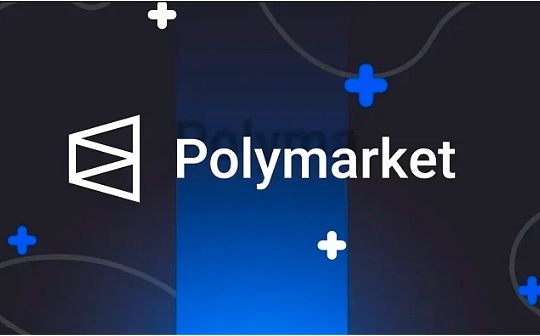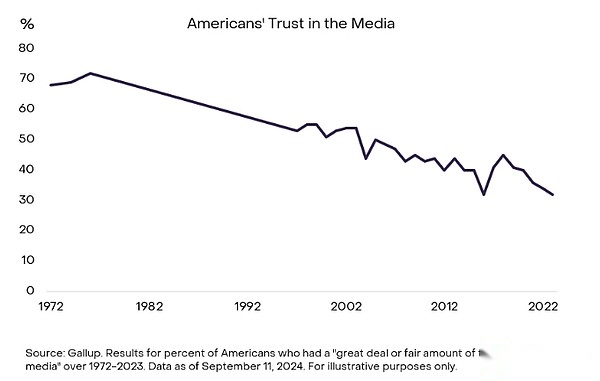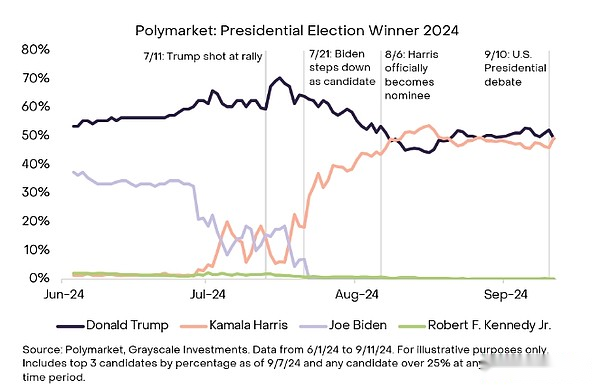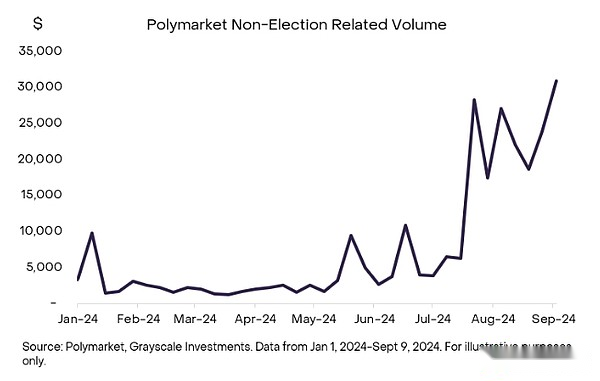
Source: Grayscale Research; Compilation: Wuzhu, bitchain vision
summary
-
Polymarket is a predictive market and breakthrough web application, and it is a classic example of how blockchain technology can help improve transparency, accessibility and trust in markets and information.
-
Polymarket allows participants to allocate funds to event contracts (for example, who will win the election).Prediction markets provide timely and often directional and accurate probability of specific events that may help investors, policy makers and/or business leaders make decisions.
-
Unlike other forecast markets, Polymarket runs on the blockchain—Polygon, which is part of the Ethereum ecosystem and smart contract platform encryption division.
-
Given the growing distrust of the media, Grayscale Research believes that Polymarket has the potential to become a “source of truth” by leveraging the transparency and recordkeeping of blockchain technology, the incentive mechanisms of the market, and the collective wisdom of users.
Policymakers often need timely and accurate information, but according to a recent poll (Figure 1), Americans’ trust in the media is currently at its lowest point in the past 50 years.With the increasing disinformation [1], nearly three-quarters of American adults believe that the news media has fueled political polarization, and nearly half express little or no confidence in the media’s ability to report news impartially and accurately..[2]
These trends raise several problems:Is it possible to obtain truly impartial information?How to inspire fact-based reporting?How do we balance the truth with reality, because profit-driven motivations may fuel one-sided narratives or undermine accuracy?
Figure 1: Declining trust in the media indicates the increasing importance of forecasting markets

Over the past two decades, technology and financial incentives have reshaped the traditional media landscape, and policy makers seem to be looking for alternatives.Grayscale Research believes that the forecast market can be part of the solution—especially those that leverage the power of blockchain technology.
Polymarket is a blockchain-based forecasting market [3] that has become the main source of probability of the 2024 U.S. presidential election in this cycle.The platform’s adoption rate has grown rapidly (see Figure 2), with increasing credibility in mainstream media, and its presidential election market odds have been added to the Bloomberg terminal recently.[4] Given the increasing distrust of the media, Grayscale Research believesPolymarket has the potential to become the “source of truth” by leveraging the transparency and recordkeeping of blockchain technology, market incentives, and the collective wisdom of users.
Figure 2: Polymarket achieves massive growth in 2024

Predicting the power of the market
A forecast market (or information market) is a platform where participants can buy and sell stocks that represent the prediction of future events.These contracts can cover almost any topic, such as politics, sports, pop culture, science, or macroeconomics.Prediction markets often offer binary options for specific results (such as “yes” or “no”).For example, participants may bet on whether a candidate will win the election.If the chances of a candidate winning increase, the value of the “yes” stock increases, and if the chances of winning decrease, the value of the “no” stock increases.
These dynamics create the probability of a given event driven by the market, reflecting the collective wisdom of the participants.
After the event results are announced, the market will process the results, betting on the right participants will be paid, and betting on the wrong participants will lose the money they invested.Regardless of personal bias, participants are financially motivated to provide accurate predictions, because the correct predictions lead to profits, while the wrong predictions lead to losses.
The forecast market originated from early political betting, dating back to 1503, when there were records of betting on the next papal election.[5] By 1884, electoral gambling became an important activity on Wall Street, but with the emergence of modern polls in the early 20th century, this activity gradually declined.[6] Over the past few decades, modern forecasting markets have emerged, including traditional platforms such as PredictIt and Kalshi, as well as blockchain-based platforms such as Augur and Polymarket.
The forecasting market was originally based on the concept of price signal proposed by Friedrich Hayek in 1945 and was able to effectively aggregate information, which often outperformed traditional prediction methods.[7] Although people are concerned about manipulation, these markets usually correct themselves and historically have been fair, given economic incentives.
Although these forecasting markets are effective, they also have risks; event-based contracts have recently faced regulatory scrutiny from the U.S. Commodity Futures Trading Commission (CFTC), which proposed banning contracts that predict political outcomes on the grounds of concern for the public (related to the economy)For more information on theory, history and regulation, see the Appendix).[8]
Polymarket Take off
Polymarket is one of the first forecast markets in modern society to gain widespread adoption (whether centralized or decentralized).During the 2024 election cycle, Polymarket’s transaction volume grew from $73 million in 2023 to $1.37 billion so far in 2024(Figure 2).In addition, the platform has become a source of data that media reporters such as the Wall Street Journal, CNN and Bloomberg have begun to use, conducting thoughtful analysis of current and sometimes controversial topics and assessing public sentiment.The platform’s website traffic has also increased significantly, from 1.4 million visits in June 2024 to 13.8 million in August 2024.[9]
This year’s U.S. presidential election fueled interest in Polymarket, driven by factors such as Trump’s assassination or Biden’s withdrawal from the campaign to support Harris (Figure 3).As shown in the figure below, the U.S. presidential election winner market on the platform reflects volatility in political odds based on these events.This particular market absorbed the largest liquidity on the platform, with trading volume reaching $776 million as of September 4.[10]
Figure 3: The U.S. Presidential Election Cycle Winner Market Attracts the Strongest Trading Activity

In addition to increasing trading volume and liquidity as attention to the November U.S. election increased, Polymarket recently invited well-known statistician and journalist Nate Silver to join the team as an advisor, and announced that it would include Ethereum founder Vitalik Buterin andInvestors such as Peter Thiel’s Founders Fund have conducted a round of financing.[11]
How Polymarket benefits from blockchain technology
Polymarket is an application on the Polygon blockchain, part of the Ethereum ecosystem and part of the crypto division of the Grayscale smart contract platform.Blockchain technology provides many advantages for Polymarket.
Polymarket combines smart contracts and decentralized decisions to resolve contracts.These services are provided by the UMA protocol, an encrypted oracle (see Grayscale Glossary).UMA records each event-based contract and its on-chain solution.If there is a disagreement, UMA will facilitate resolution through community voting – all of which are also documented on the chain.This mechanism helps ensure that market disputes are resolved without being disturbed by centralized, arbitrary or potential bias.
In addition, blockchain provides payment channels to achieve 24/7 global accessibility.This makes access to the Polymarket platform at low cost without any barriers to accessing the Polymarket platform – unlike many centralized or Web 2.0 applications.
A platform with endurance
Polymarket has reached new levels of coverage with its frequent news citations and a large number of content followers (see Figure 4).Today, its liquidity advantages and network effects have theoretically created a more efficient market than competitor platforms.Grayscale Research believes this provides a considerable moat for Polymarket, making it more attractive to potential users.
Figure 4: Polymarket leads forecasting competitors on most key metrics

While Polymarket relies primarily on election-related transaction volumes, trading volumes on other content have also increased recently (Figure 5), partly due to interest in the 2024 Olympics.As of September 7, 2024,Five of the top 10 markets by volume are not related to the election, including Super Bowl odds, the Fed rate cut and the highest-grossing movies in 2024.[12]
Still, election-related contracts account for most activities, including more than 70% of the total weekly transaction volume since June.[13] Therefore,Polymarket has the potential to capitalize on the two-month window before the U.S. election to maximize interest in its platform.After the election,We believe Polymarket has a huge opportunity to capitalize on its growing content coverage and current position in the preferred forecast market,Push trading volume to new areas such as sports, pop culture and science.This will be crucial if the platform hopes to continue growing after the November election.
Figure 5: Polymarket’s non-election-related transaction volume has increased since July 2024

Risks and precautions
Polymarket faces certain risks, especially in regulation.In 2022, Polymarket was fined by the CFTC for providing the market without proper registration.The platform appears to be taking prudent measures since 2022, but the regulatory status of the forecast market remains pending due to the 2024 CFTC’s proposal to ban election-related events.Additionally, recent activities and enthusiasm may fade away once the election is over.
Summarize
Polymarket has become one of the best examples of use cases gained in crypto ecosystems based on organic growth.now,Polymarket token or airdrop driver activity has not yet appeared—there is only one product that resonates with users.
At a time when many crypto applications are considered too confusing or overly technical for non-encrypted native users, Polymarket stands out by providing direct purpose and an intuitive, familiar user experience.It also does what most crypto apps can’t do – starting to attract attention and mainstream credibility from traditional institutions and media.
It is worth noting thatPolymarket is pioneered by technology and products rather than tokens and commercialization, which allows users and media to recognize its value without having to know that the backend uses blockchain technology.
The Grayscale Research team has previously written about how the 2024 U.S. election becomes a “crypto election”, and encryption is increasingly becoming a related issue in the campaign trial.Crypto apps are attracting attention, especially in the context of declining media trust and increasing polarization, highlighting the potential role of Polymarket—more broadly—providing a reliable, transparent alternative to noise.Plan to find the truth.
appendix
history:Early modern forecasting markets include historical projects such as Iowa Electronics Market, DARPA’s policy analysis market and gaming currency platforms such as HSX.com.Over the past decade, several new companies have emerged, including 2014 PredictIt, a subsidiary of Victoria University in Wellington.In 2018, Kalshi, a centralized forecasting market regulated by the CFTC, was established, and Augur became the first decentralized forecasting market on Ethereum.In 2020, Polymarket was launched on the Polygon blockchain.
Economic Theory:The economic theory behind the prediction market stems from Friedrich Hayek’s concept of price signals, which effectively summarizes and disseminates information in the economy.[14] Robert Schiller’s research on macro markets such as TIPS and GDP warrants shows how financial instruments hedge economic risks and capture collective expectations is similar to the role of predicting markets in predicting outcomes.Research shows that the forecasting market is very accurate and often goes beyond traditional prediction methods because it can aggregate various information.[15] Concerns about manipulation (such as candidates betting on themselves) are often exaggerated because these markets can quickly correct themselves.[16] In addition, the forecasting market is often unbiased and can capture collective beliefs without being significantly affected by individual behavior.[17]
Supervision:Event-based contracts have traditionally been regulated by the CFTC, and the agency prohibits any contract that involves “illegal activities” or “violating the public interest” activity.In 2024, the CFTC proposed a rule that prohibits event contracts involving political outcomes, trying to classify them as contracts that are “violating the public interest.”[18]
How it works:Here is a brief overview of the components of Polymarket:
Conditional Token Framework (CTF):Polymarket tokenize binary results on the Polygon network into ERC1155 tokens using Gnosis’s CTF.This allows the collateral to be split into result tokens and merged upon settlement.
Mixed Order Book Model:Polymarket uses a hybrid decentralized order book model, also known as the Central Limit Order Book (CLOB).The model involves operators that provide off-chain matching and subscription services, while settlement and execution of transactions are performed on-chain in an unmanaged manner.This setting also includes the option to trade with an automated market maker (AMM).
Decentralized oracle (UMA):Polymarket mainly uses UMA’s optimistic oracle to solve market problems (Pyth is also used in certain markets).If there is a dispute over the outcome of a particular event, UMA token holders will vote to determine the correct outcome.
Review proposal:The Polymarket team is currently responsible for reviewing new campaign proposals and acting as a necessary centralized participant to ensure that the event contract is worded correctly.
USDC Market:The market mainly uses USDC as the basic collateral.This stablecoin-based approach simplifies transactions and provides a stable medium of value for market participation.
Polygon settlement layer:The settlement of transactions and market resolutions on Polymarket takes place on the chain on the Polygon network.
Currently, Polymarket charges a small fee (2%) from the winning bet, but does not take this fee home as income, but rewards liquidity providers instead.Additionally, a small portion of this fee is used to pay for transaction fees on the Polygon blockchain.Users also need to pay a small gas fee when depositing and withdrawing money.The founder of Polygon also hinted at an additional fee sometime in the future.[19] To date, Polymarket has subsidized some of the growth of market makers on its platform, paying liquidity providers more than $3 million in USDC rewards to increase liquidity depth.[20]
References
[3] The Forecast Market (or Information Market) is a platform where participants can buy and sell stocks that represent the prediction of future event results.
[4] During this election cycle, Polymarket has developed significant appeal, with trading volume so far in 2024 growing to XX and widely cited by media such as the Wall Street Journal, CNN and Bloomberg.
[5]Rhode, Strumpf. “The Long History of Political Betting Markets.”
[6]Rhode, Strumpf. “The Long History of Political Betting Markets.”The forecast market has evolved from early political betting to modern platforms, such as PredictIt launched in 2014 by Victoria University of Wellington.In 2018, Kalshi, a centralized forecasting market regulated by the CFTC, was established, and Augur became the first decentralized forecasting market on Ethereum.In 2020, Polymarket launched on the Polygon blockchain, adding new content to a diverse landscape including the Iowa Electronics Market, DARPA Policy Analysis Market and game currency platforms such as HSX.com.
[7]Hayek. “The Use of Knowledge in Society.”
[8] “Statement on Prediction Markets”, Kenneth Arrow, 2007.
[9] Similar Web
[10] Polymarket
[12] Polymarket
[14]Hayek. “The Use of Knowledge in Society.”
[15] Wolfers, 2004
[16] Snowberg, 2012
[17] Berg, 2018








